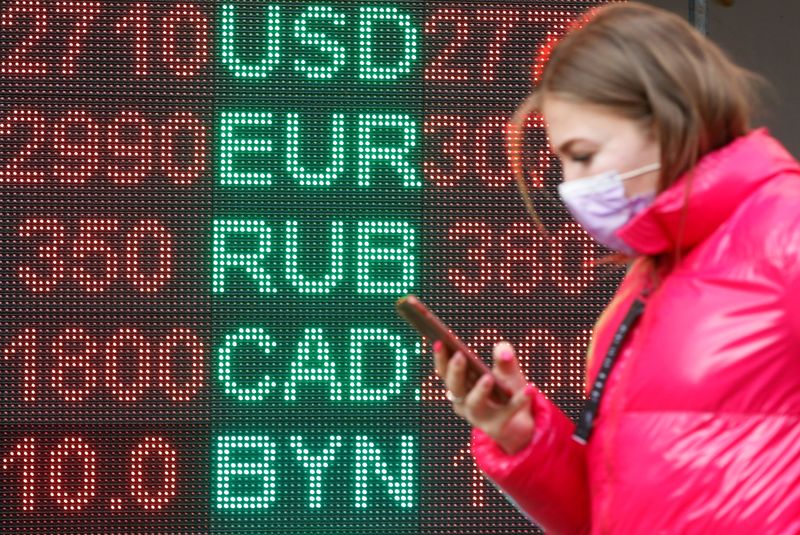By Saqib Iqbal Ahmed and Ira Iosebashvili
NEW YORK (Reuters) - Investors are betting a weaker U.S. dollar will further boost a rally that has seen stocks, emerging market currencies and other risky assets soar in recent weeks.
The dollar is down 6.6% against a basket of currencies from a more than three-year high in late March, the sharpest 21-day drop in about 2 years. Net bets against the U.S. currency in futures markets
(GRAPHIC - U.S. Dollar Index & CFTC Positions: https://fingfx.thomsonreuters.com/gfx/mkt/dgkplwzqkvb/Dollar%20index%20and%20spec%20positions.jpg)
Several factors are driving the dollar lower. Investors piled into the dollar and other so-called havens during a coronavirus-fueled global stock sell-off in March. Trillions in stimulus from the world's central banks and, more recently, signs of stabilization in U.S. growth, have reignited risk appetite and boosted the case for shifting back into equities and other comparatively risky areas.
The S&P 500 (SPX) is up 46% from its late-March low, while the Nasdaq (IXIC) recently marked a new bull market.
At the same time, the Fed’s pledge to keep U.S. rates near zero for the foreseeable future and potentially cap yields has diminished the dollar’s attractiveness to income-seeking investors and raised the allure of higher-yielding currencies.
“The Fed put is bigger than ever,” said Paresh Upadhyaya, a portfolio manager at Amundi Pioneer Asset Management. “This is ultimately negative for the dollar and positive for risky assets.”
Upadhyaya is betting the dollar will decline against a range of currencies including the euro, Australian dollar, Indonesian rupiah and Mexican peso.
Because of the dollar's central role in the global financial system, its fluctuations tend to have widespread repercussions.
A weaker buck is welcome for U.S. multinationals by making it cheaper to convert foreign earnings back into dollars, potentially boosting balance sheets that had suffered in the coronavirus-led slowdown.
The materials and technology sectors are among the most exposed to currency headwinds, with around 50% of the corporations in both sectors deriving the greater part of their revenues from abroad, an analysis of Russell 1000 companies by Bespoke Investment Group showed earlier this year.
A weaker dollar also tends to be a tailwind for oil and other raw materials, which are denominated in dollars and become more affordable to foreign buyers when the U.S. currency declines. The S&P/Goldman Sachs Commodity Index (SPGSCI) has rallied about 45% over the last 30 days.
The falling dollar "unleashes a 'virtuous cycle' that lifts the global economy," said Karl Schamotta, chief market strategist at Cambridge Global Payments in Toronto.
Among the risk-seeking strategies that have prospered in recent weeks is the carry trade, where investors borrow in a low-yielding currency and roll their money into a higher-yielding one, pocketing the difference.
An investor selling dollars and buying the Brazilian real, for instance, would have earned 17.4% over the last month accounting for the difference in yield and the real's swift rise from recent lows, according to Cambridge Global Payments data through Monday. The Mexican peso has returned nearly 10% in the same period, and the Russian ruble 7.7%.
Stephen Innes, chief market strategist at Australian FX services provider AxiCorp, recently sold the dollar to purchase the much higher-yielding Indonesian rupiah
Thanks to low U.S. rates, "the U.S. dollar is looking more attractive as a funding currency than at any time in the past two years," he said.
(GRAPHIC - Rate differentials: USD vs select currencies: https://fingfx.thomsonreuters.com/gfx/mkt/xklpyglrjpg/rates.JPG)
Some believe the dollar's losses may be limited. The gap between U.S. rates and those in Europe and Japan - where many borrowing costs are negative - is unlikely to narrow much further in the near term, with the Fed opposed to moving borrowing costs below zero.
At the same time, few are willing to completely turn their back on haven assets such as the dollar with the trajectory of the coronavirus pandemic still uncertain and the global economy at its weakest in decades.
A rapid resurgence in coronavirus cases or signs that renewed U.S.-China trade frictions may further damage an already-battered global economy could send investors scrambling back into the dollar, analysts said.
Such a scenario could be disastrous for carry traders, potentially wiping out weeks of gains in several sessions.

"I think of carry strategies as being to similar picking up nickels in front of a steamroller," said Schamotta.